snow chains AUDI S6 2009 Owners Manual
[x] Cancel search | Manufacturer: AUDI, Model Year: 2009, Model line: S6, Model: AUDI S6 2009Pages: 398, PDF Size: 43 MB
Page 172 of 398
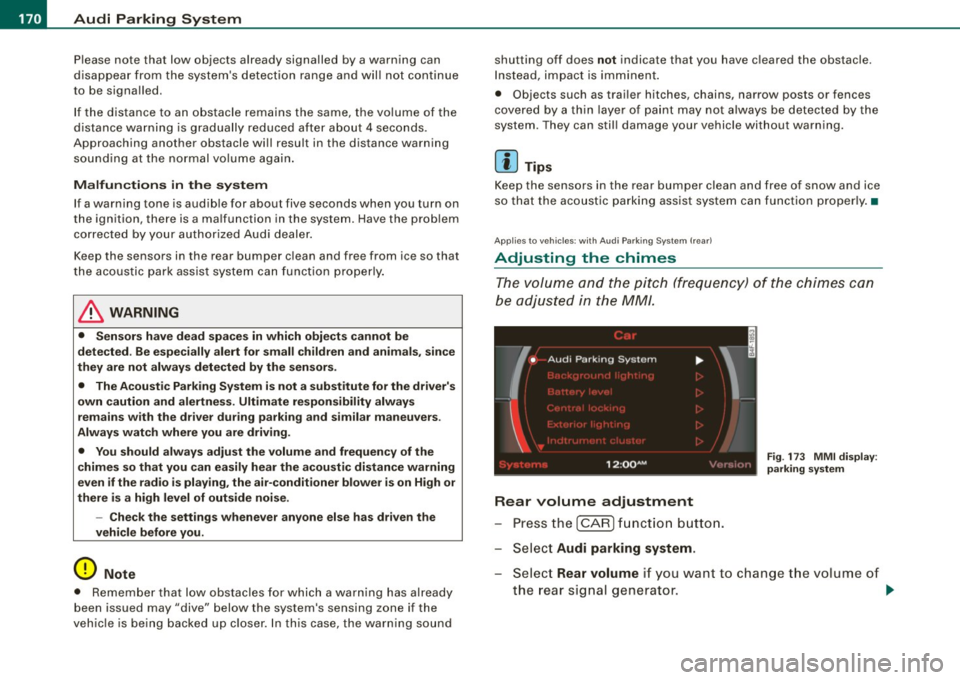
• .___A_ u_d_ i _P _a_ r_ k_ i_ n ..:g=-- S_ y=-- s_t _ e _m _____________________________________________ _
Please note that low objects already signalled by a warning can
disappear fro m the system 's detectio n range and wil l n ot con tinu e
to be signa lled .
If the distance to an obstacle remains the same, the vo lume of the
d istance wa rni ng i s gradually reduced after a bout 4 seconds .
Approaching another obstacle wi ll result in the distance warning
sound ing at the nor mal vo lume agai n.
Malfunctions in the system
If a warnin g tone is audible for about five seconds when you turn on
the ignition, there is a ma lfunction in the system. Have the prob lem
corrected by y our aut horiz ed Aud i dealer .
Keep the sensors in the rear bumper c lean and free from ice so that
t he acoustic park ass is t sy ste m can f unction pro per ly .
& WARNING
• Sensors have dead spaces in which objects cannot be
detected . Be e specially alert for small children and animals , since
they are not always detected by the sensors.
• The Acoustic Parking System is not a substitute for the dr iver's
own caution and alertne ss. Ultimate respon sibility always
remains with the driver during parking and similar maneuvers .
Always watch where you are driving .
• You should always adjust the volume and frequen cy of the
chimes so that you can easily hear the acoustic distance warning
even if the radio is playing , the air-condit ioner blower is on High or
there i s a high level of out side noise .
- Check the settings whenever anyone else has driven the
vehicle before you.
0 Note
• Reme mber that l ow obstacles for wh ic h a warn ing has already
been issued may "dive" below the system's sensing zone if the
v e h icl e is be ing backed u p closer. In this cas e, th e wa rning so und shutting off does
not indicate that you have c
leared the obstacle .
In stea d, impact is im min ent.
• Objects such as trai ler hitches, chains, narrow posts or fences
cov ered by a t hin lay er of p ain t may no t always be dete cte d by t he
system . T hey can stil l damage your vehicle without warning.
[ i ] Tips
K eep the sensors in the rear bumper clean and free of snow and ice
so tha t the acou stic parki ng a ssis t system ca n fu nc tio n proper ly . •
Ap plie s to v ehic le s : w ith Audi P arki ng Syst em ( re arl
Adjusting the chimes
Th e vo lum e and t he pitc h (freq uency) o f th e c him es can
be adju ste d i n th e
MM/ .
Rear volume adjustment
Pre ss th e [ CAR ] fun ctio n butt on.
S el ect
Audi parking system.
Fig. 173 MMI display :
pa rking system
S elect Rear volume if you want to change t he volume of
t h e rear si gnal genera tor .
~
Page 176 of 398
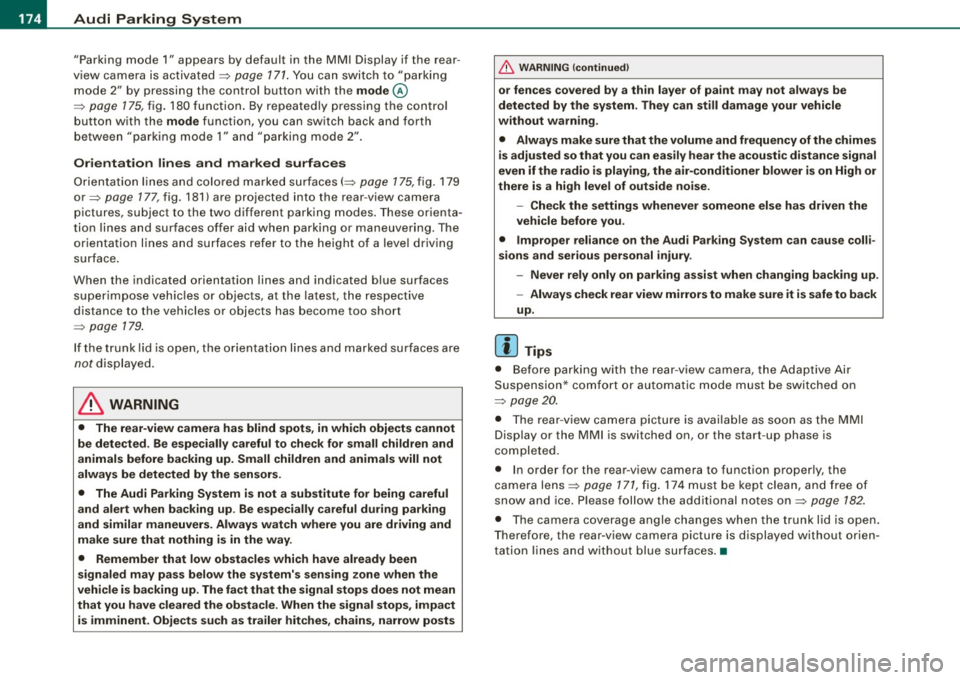
_____ A_ u_d _ i_ P_ a_r _k _in _ g=- S--=- y_s _t _e _m ____________________________________________ _
"Parking mode 1" appears by default in the MMI Display if the rear
v iew came ra is activate d=>
page 171 . You can switch to " parki ng
mode
2" by pressing the control button with the mode @
=> page 175, fig. 180 function . By repeatedly p ressing the control
button with the
mode function, you can switch back and forth
between "parking mode
1 " and "pa rking mode 2".
Orientation lines and marked surfa ces
Orientati on l ines and col ored ma rke d surfaces( => page 175, fig . 179
or => page 177, fig. 181) a re projected into the rear -view ca mer a
pictu res, subject to the two diffe rent par king modes . These orienta
tion lines and surfaces offer aid when parking or maneuvering. The
orientation lines and su rfaces refer to the height of a leve l driving
sur face.
When the indicated orientation lines and indicated blue surfaces
sup erimpos e veh ic le s or o bjects, a t the lates t, t he respectiv e
d istance to the vehicles or objects has become too short
=>
p age 179 .
If the tr unk lid is open, the o rien tat io n lin es and marked su rfaces are
not displayed .
& WARNING
• The rear-view camera has blind spots , in which objects cannot
be detected . Be especially careful to check for small children and
animals before backing up . Small children and animals will not
always be detected by the sensors.
• The Audi Parking System is not a substitute for being careful
and alert when backing up . Be especially careful during parking
and similar maneuvers . Always watch where you are driving and
make sure that nothing is in the way.
• Remember that low obstacles which have already been
signaled may pass below the system 's sensing zone when the
vehicle is backing up . The fact that the signal stops does not mean
that you have cleared the obstacle . When the signal stops , impact
is imminent . Objects such as trailer hit ches, chains , narrow posts
& WARNING (continued )
or fences covered by a thin layer of paint may not always be
detected by the sy stem. They can still damage your vehicle
without warning .
• Always make sure that the volume and frequency of the chime s
is adjusted so that you can easily hear the acoustic distance signal
even if the radio is playing , the air -conditioner blower is on High or
there is a high level of outside noise .
- Check the settings whenever someone else has driven the
vehicle before you .
• Improper reliance on the Audi Parking System can cause colli
sions and serious personal injury .
- Never rely only on parking assi st w hen changing backing up .
- Always check rear view mirrors to make sure it is safe to back
up .
[ i ] Tips
• B efore parking with the rear -view camera, the Adaptive Air
Su spensi on* co mfort or automatic mode must be switched on
=>
page 20.
• The rea r-v iew ca mera pic ture is avai la bl e as soon as the M MI
Display or the MMI is sw itched on, or the start -up phase is
completed.
• I n order for the rear-view camera to function proper ly, the
c a m era len s=>
page 171 , fig. 17 4 mu st be kept clea n, a nd free of
snow and ice. P lease follow the additional notes on=>
page 182.
• The came ra c overage a ngle changes when the trunk lid is open .
T herefore, the rear-view camera picture is d isplayed without orien
t a tion lin es an d w ith out blue surfaces .•
Page 266 of 398
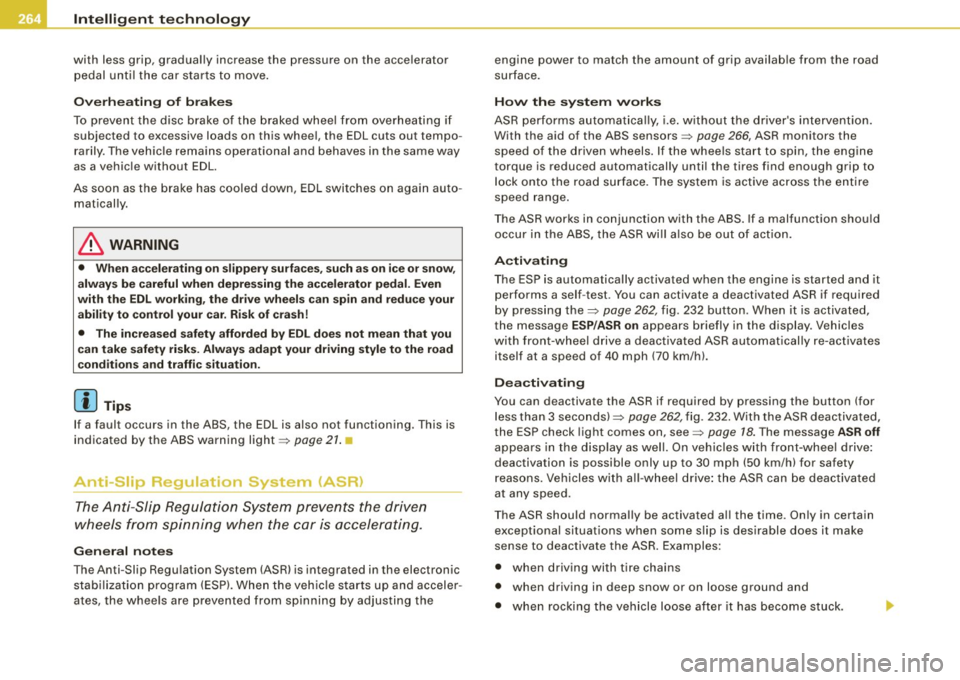
___ ln_ t _e_ ll-'"ig ...,_ e_ n_t _t_ e_ c_ h _ n_o _ l_o _,.g= y,_ __________________________________________ _
with less grip, gradually increase the pressure on the accelerator
pedal until the car starts to move.
Overheating of brakes
To prevent the disc brake of the braked wheel from overheating if
subjected to excessive loads on this wheel, the EDL cuts out tempo
rarily. The vehicle remains operational and behaves in the same way
as a vehicle without EDL.
As soon as the brake has cooled down, EDL switches on again auto
matically.
& WARNING
• When accelerating on slippery surfaces, such as on ice or snow,
always be careful when depressing the accelerator pedal. Even
with the EDL working, the drive wheels can spin and reduce your
ability to control your car. Risk of crash!
• The increased safety afforded by EDL does not mean that you
can take safety risks. Always adapt your driving style to the road
conditions and traffic situation.
[ i] Tips
If a fault occurs in the ABS, the EDL is also not functioning. This is
indicated by the ABS warning light=>
page 21. •
Ant"-Slip Regulation System (ASR)
The Anti-Slip Regulation System prevents the driven
wheels from spinning when the car is accelerating.
General notes
The Anti-Slip Regulation System (ASR) is integrated in the electronic
stabilization program (ESP). When the vehicle starts up and acceler
ates, the wheels are prevented from spinning by adjusting the engine power to match the amount of grip available from the road
surface.
How the system works
ASR
performs automatically, i.e. without the driver's intervention.
With the aid of the ABS sensors=>
page 266, ASR monitors the
speed of the driven wheels. If the wheels start to spin, the engine
torque is reduced automatically until the tires find enough grip to
lock onto the road surface. The system is active across the entire
speed range.
Th e ASR works in conjunction with the ABS. If a malfunction should
occur in the ABS, the ASR will also be out of action.
Activating
The ESP is automatically activated when the engine is started and it
performs a self -test . You can activate a deactivated ASR if required
by pressing the =>
page 262, fig. 232 button . When it is activated,
the message
ESP/ASR on appears briefly in the display. Vehicles
with front-wheel drive a deactivated ASR automatically re-activates
itself at a speed of 40 mph (70 km/h) .
Deactivating
You can deactivate the ASR if required by pressing the button (for
less than 3 seconds)=>
page 262, fig. 232. With the ASR deactivated,
the ESP check light comes on, see=>
page 18. The message ASR off
appears in the display as well. On vehicles with front-wheel drive:
deactivation is possible only up to 30 mph (50 km/h) for safety
reasons . Vehicles with all -wheel drive: the ASR can be deactivated
at any speed .
The ASR should normally be activated all the time. Only in certain
exceptional situations when some slip is desirable does it make
sense to deactivate the ASR. Examples:
• when driving with tire chains
• when driving in deep snow or on loose ground and
• when rocking the vehicle loose after it has become stuck .
Page 270 of 398
![AUDI S6 2009 Owners Manual ___ ln_ t _e_ ll-"ig ...,_ e_ n_t _t_ e_ c_ h _ n_o _ l_o _,.g= y,_ __________________________________________ _
[ i] Tips
• When the engine is running, never hold the steering wheel AUDI S6 2009 Owners Manual ___ ln_ t _e_ ll-"ig ...,_ e_ n_t _t_ e_ c_ h _ n_o _ l_o _,.g= y,_ __________________________________________ _
[ i] Tips
• When the engine is running, never hold the steering wheel](/img/6/57595/w960_57595-269.png)
___ ln_ t _e_ ll-'"ig ...,_ e_ n_t _t_ e_ c_ h _ n_o _ l_o _,.g= y,_ __________________________________________ _
[ i] Tips
• When the engine is running, never hold the steering wheel
turned all the way to the right or to the left for longer than
15 seconds . The power steering pump will overheat the hydraulic
fluid if you keep holding th e steering wheel turned all th e way. This
is likely to damage the power steering system.
• If the power steering system should fail entirely, or if the engine
is not running (for example, while being towed), you will still be able
to ste er th e vehicle . However,
considerably mor e effort will be
required to do so.
• If the power steering system should have a leak, or is not func
tioning properly, contact your authorized Audi dealer immediately.
• The power steering system requires a specially formulated
hydraulic fluid. The power steering reservoir is the one located most
forward on the left side of the engine compartment=>
page 302. The
correct fluid level in the reservoir is important for proper func
tioning of the power ste ering. •
Applies to vehicles : wit h A ll Wh eel Drive
Driving with your quattro®
With All Wheel Drive, all four wheels are driven.
General information
With All Wheel Drive, power is distributed to all four wheels. This
happens automatically depending on your driving style and the
road conditions at the time . See also=>
page 263, "Electronic differ
ential lock (EDU".
Winter tires
When driving in the winter, your vehicle with All Wheel Drive has an
advantage, even with regular tires. In winter road conditions it may be advisable to mount winter tires (or all-season tires) for improved
driveability and braking: these tires must be mounted on
all four
wheels.
See also => page 333, "Winter tires".
Tire chains
Where tire chains are mandatory on certain roads, this normally
also applies to vehicles with All Wheel Drive=>
page 334, "Snow
chains".
Replacing wheels/tires
Vehicles with All Wheel Drive must always have tires of the same
si ze. Also avoid tires with different tread depths. For details see
page =>
page 329, "New tires and replacing tires and wheels".
Off-Road driving?
Your Audi does not have enough ground clearance to be used as an
off-road vehicle. It is therefore best to avoid rough tracks and
uneven terrain as much as possible. Also refer to=>
page 273.
& WARNING
Always adjust your driving to road and traffic conditions. Do not
let the extra safety afforded by All Wheel Drive tempt you into
taking extra risks.
• Although the All Wheel Drive is very effective, always
remember that braking capacity is limited by tire traction. You
should therefore not drive at excessive speeds on icy or slippery
road surfaces.
• On wet road surfaces, be careful not to drive too fast because
the front wheels could begin to slide on top of the water (aqua planing}. If this should occur, you will have no warning from a
sudden increase in engine speed as with a front-wheel drive
vehicle. Always drive at speeds which are suited to the road condi
tions -risk of crash. ,
Page 336 of 398
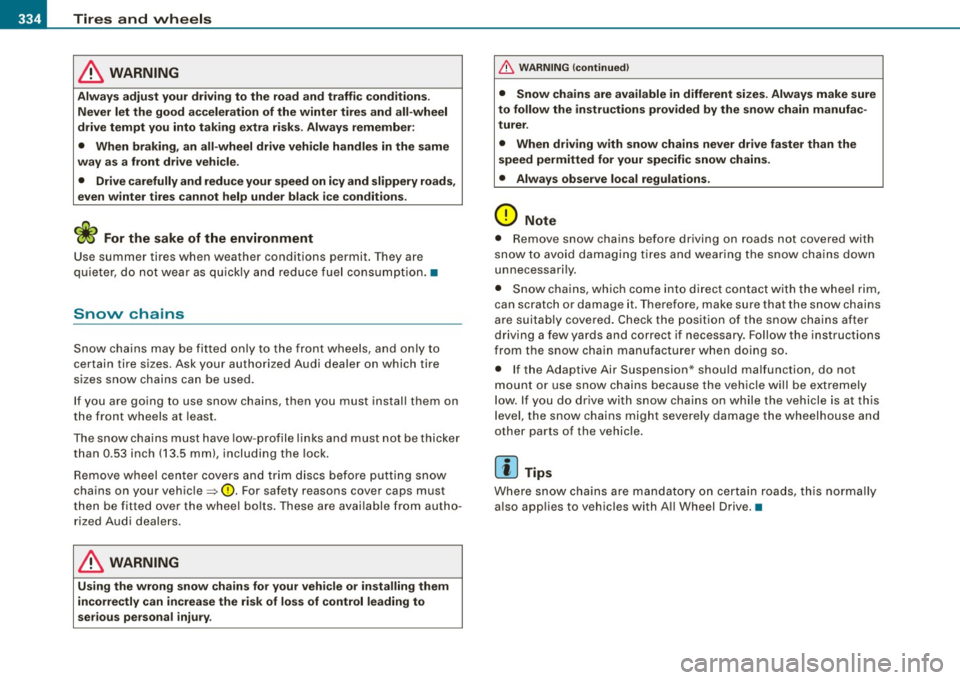
-~_T_ ir_e_ s_ a_ n_d _ w_ h_ e_e _l_s _________________________________________________ _
& WARNING
Always adjust your driving to the road and t raffic condit ions .
Never let the good a cceleration of the winter tires and all -wheel
dri ve tempt you into tak ing extra ri sk s. Always remember :
• When braking, an all -wheel drive vehicle handles in the same
way as a front drive vehicle .
• Drive carefully and redu ce your speed on icy and sli ppery roads ,
even winter tires cannot help unde r bla ck ice conditions.
c£> For the sake of the environment
Use summer tires when weather conditions permit. They are
quieter, d o no t wear as quick ly a nd re duce fuel consump tio n.•
Snow chains
Snow cha ins may be fitte d o nly to the fron t whee ls, and o nly to
certain tire sizes . Ask your authorized Audi dealer on which tire
s iz es snow c hains can be used.
If you are going to use snow chains, then you must install them on
the front wheels at least.
The snow cha ins must have low -profile l inks and must not be thicker
than 0 .53 inch ( 13.5 mm), including the lock.
Remove wheel center c overs and trim discs before putt ing snow
chains on your vehicle~
0 . For safety reasons cover caps must
then be fitted ove r the wheel bo lts . These are avai lable from autho
r ized Aud i dealers.
& WARNING
Using the wrong sno w chains for your vehi cle or installing them
incorre ctly can in crease the risk of loss of control leading to
serious personal injury .
& WARNING (continued )
• Snow chains are available in different sizes. Alw ay s make sure
to follo w the instructions provided by the snow chain m anufac
turer .
• When driving with snow cha ins never drive faster than the
s peed permitted for your specific snow chains .
• Alway s observe lo cal regu lations.
0 Note
• Remove snow c hains before driving on roads not covered with
snow t o av oid da maging tires a nd wea ring the snow cha in s dow n
unnecessari ly.
• Sno w cha in s, w hich come in to direc t contact wi th th e wheel ri m,
can scratch or damage it. Therefore, make sure that the snow chains
a re sui tab ly cove red. Check the position of t he snow cha ins a fter
driving a few yards and correct if necessary . Follow the instructions
from the snow chain manufacture r when doing so .
• I f the Adaptive Air Suspension * shou ld malfunction, do not
mo unt or use snow chains because the veh icle w ill be ext remely
l ow . If you do drive with snow chains on while the vehicle is at this
l evel, the snow chains might severe ly damage the wheelhouse and
other parts of the vehicle.
[ i ] Tips
Where snow c hains a re ma ndatory on ce rtai n roa ds, th is norma lly
a lso app lies to veh ic les with A ll Wheel Drive. •
Page 340 of 398
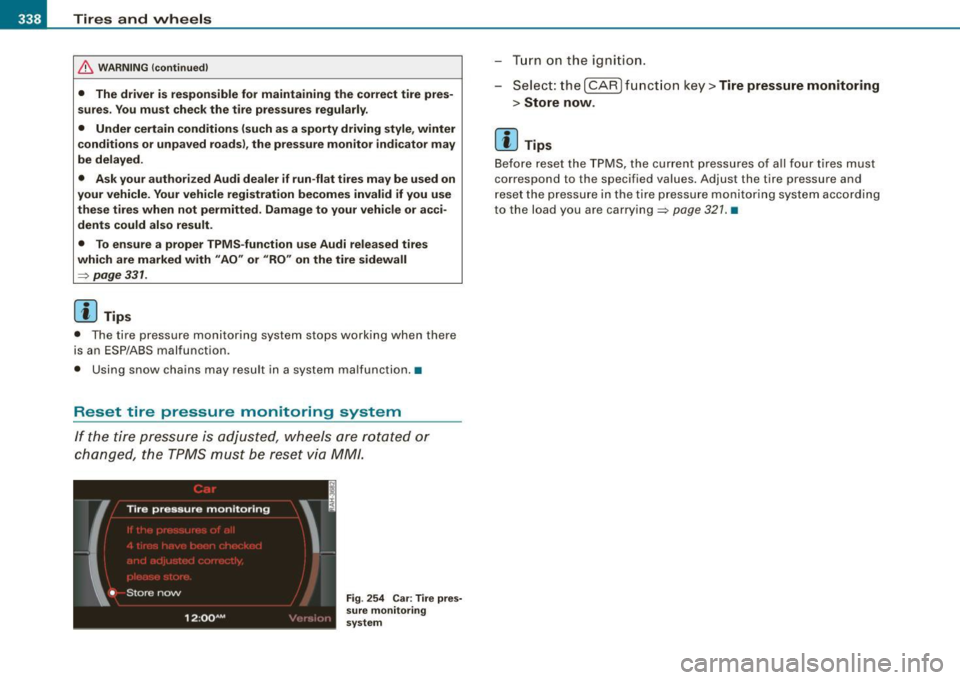
___ T_ i_ r_e _s_ a_ n_ d_ w_ h_ e_ e _ ls _________________________________________________ _
& WARNING (con tinued )
• The driver is respon sible for maintaining th e correct tire pres
s ures . You must check the tire pre ssure s regularly .
• Under certain conditions (such as a sporty driving style , winter
cond itions or unpaved roads ), the pressure monitor indicator may
be delayed.
• Ask your authorized Audi dealer if run -flat tires may be used on
your vehicle. Your vehicle registration becomes invalid if you use
the se tires when not permitted. Damage to your vehicl e or acci
dents could also result .
• To ensure a p roper TPMS -function use Audi relea sed tires
which are marked with "AO " or "RO " on the tire sidewall
=> page 331 .
[ i ] Tips
• The tire pressure monitoring system stops work in g when there
is an ES P/ABS malfunct ion.
• Using snow chains may resu lt in a system ma lfunction. •
Reset tire pressure monitoring system
If the tire pressur e is adju sted , whee ls are rotated or
c hang ed, the T PMS must be reset vi a MM/ .
Fig. 254 Car : Tire pre s
sure m onitoring
sys tem
T ur n on th e i gni tio n.
- Selec t: the [ CA R) f un ctio n k ey>
Tire pressure monitoring
> Store now .
[ i ] Tips
Befor e reset t he TPMS, the c urrent pressur es o f all four t ires must
correspond to the speci fied values. Adjust the tire pressure and
r ese t th e press ure i n t he tire p ress ure moni tori ng system accord ing
to the load you are carry ing=>
page 321. •
Page 392 of 398
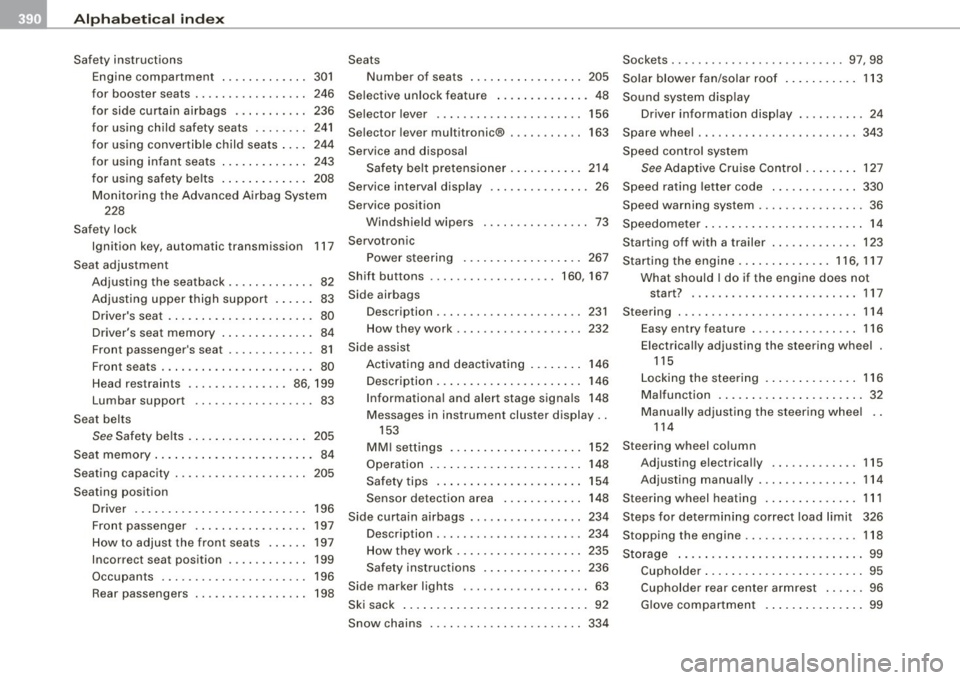
-Alphab eti ca l ind ex
-----=-------------------------------------
Safety instructions
Engine compartment ... .. .... .... 301
for booster seats . . . . . . . . . . . . . . . . . 246
for side curtain airbags .... ....... 236
for using child safety seats . ... .... 241
for us ing convertible child seats .... 244
for using infant seats ... .. .... .... 243
for using safety be lts . .... ... .... . 208
Monitoring the Advanced Airbag System 228
Safety lock Ignition key, automatic transmission 117
Seat adjustment Adjusting the seatback ... .... .... .. 82
Adjusting upper thigh support ...... 83 Driver's seat . . . . . . . . . . . . . . . . . . . . . . 80
D .
' t 84
river s sea memory . .... ...... .. .
Front passenger's seat . . . . . . . . . . . . . 81
Front seats . . . . . . . . . . . . . . . . . . . . . . . 80
Head restraints ... .... .... ... . 86, 199
Lumbar support ............. ..... 83
Seat belts
See Safety be lts . .... ... .. .... .... 205
Seat memory . . . . . . . . . . . . . . . . . . . . . . . . 84
Seating capacity . .... .... .... ... .... 205
Seating position Driver ...... ... .. .... ...... .... . 196
Front passenger . . . . . . . . . . . . . . . . . 197
How to adjust the front seats . . . . . . 197
Incorrect seat position . . . . . . . . . . . . 199
Occupants ...................... 196
Rear passengers . . . . . . . . . . . . . . . . . 198 Seats
Number of seats ..... .... .... .... 205
Selective unlock feature .... ....... ... 48
Selector lever . . . . . . . . . . . . . . . . . . . . . . 156
Se lector lever mu ltitronic® ........... 163
Service and disposal Safety be lt pretensioner ...... .... . 214
Service interval display . . . . . . . . . . . . . . . 26
Service position Windshield wipers . . . . . . . . . . . . . . . . 73
Servotron ic Power steering ...... .... .... .... 267
Shift buttons ...... .. ........... 160, 167
Side airbags
Description .............. ...... .. 231
How they work . . . . . . . . . . . . . . . . . . . 232
Side assist Activating and deactivating ... .... . 146
Description .......... ........ .... 146
Informationa l and alert stage signals 148
Messages in instrument cluster display ..
153
MM I settings ... .... ... .. ...... .. 152
Operation . . . . . . . . . . . . . . . . . . . . . . . 148
Safety tips . . . . . . . . . . . . . . . . . . . . . . 154
Sensor detection area . . . . . . . . . . . . 148
Side curtain airbags .. ........ ....... 234
Description ...................... 234
How they work . . . . . . . . . . . . . . . . . . . 235
Safety instructions .......... .... . 236
Side marker lights . . . . . . . . . . . . . . . . . . . 63
Ski sack ... .. .... ...... .... ... .... .. 92
Snow chains . .... ....... ........... 334 Sockets
.. ...... .... .... .... ... .. . 97, 98
Solar blower fan/solar roof ....... ... . 113
Sound system disp lay
Driver information disp lay .......... 24
Spare wheel ........................ 343
Speed control system
See Adaptive Cruise Control .. .... .. 127
Speed rating letter code ... ... .... ... 330
Speed warning system ................ 36
Speedometer .... .... .... ....... .... . 14
Starting off with a trailer .. .... .... ... 123
Starting the engine .. .... ... .. ... 116, 117
What should I do if the engine does not
start? ........................ . 117
Steering . ........... ....... ... .. ... 114
Easy entry feature ................ 116
Electrically adjusting the steering wheel .
115
Locking the steering ... .... .... ... 116
Malfunction . ... .. .... .... .... .... 32
Manually adjusting the steering whee l
114
Steering wheel column Adjusting electrically ... .... ...... 115
Adjusting manual ly ............... 114
Steering wheel heating .. ........ .... 111
Steps for determining correct load limit 326
Stopping the engine .... ... .......... 118
Storage .... ... .. .... ..... .. ... ..... 99
Cupholder ... .. ...... .... .... ... .. 95
Cupholder rear center armrest ... .. . 96
Glove compartment ... .... .... .... 99
Page 393 of 398
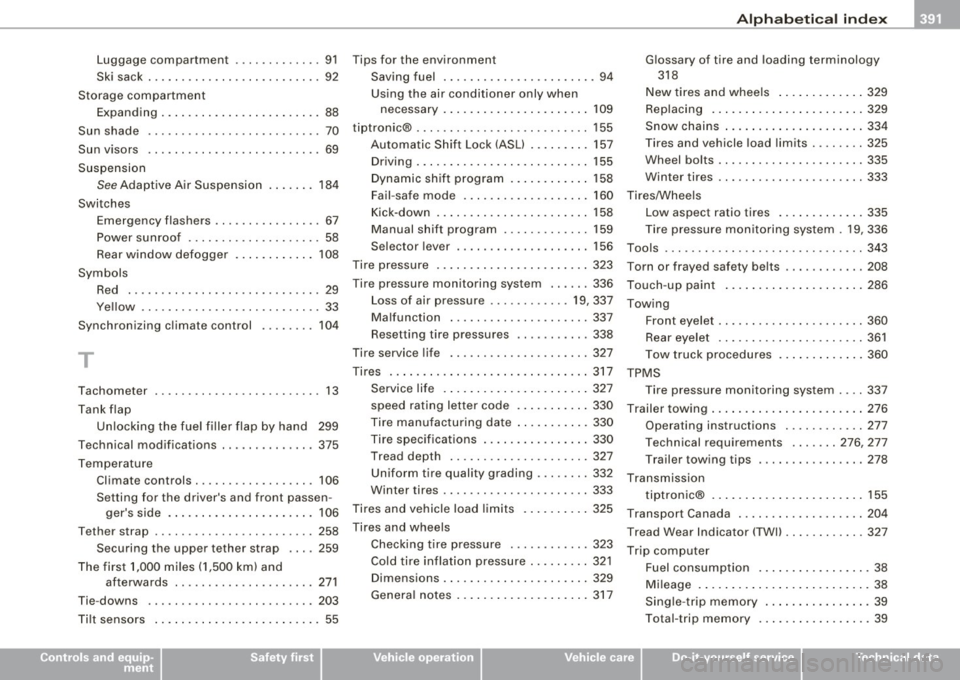
______________________________________________ A_ l_,_ p _h_ a_ b_e _t_i c_ a _ l _in _ d_e _ x __ _
Luggage compartment ... ... . ..... . 91
Ski sack . .... .... .... .... ..... .. .. 92
Storage compartment
Expanding . ... ...... .. ... .. .... ...
88
Sun shade .. .... .... ... .... ... .... .. 70
Sun visors .. .... ... ... ..... ...... ... 69
Suspension
See Adaptive Air Suspension . .... .. 184
Switches
Emergency flashers .. .... .... .... ..
67
Power sunroof .... ... .... .... .... . 58
Rear window defogger ... ... . ... .. 108
Symbols
Red . ...... .. ..... ... ..... .. .....
29
Yellow .. .. ... ... .... .... ... .... .. 33
Synchronizing climate control . ... .... 104
T
Tachometer . .... .... .... ... .... .... . 13
Tank f lap
Unlocking the fuel filler flap by hand
299
Technical modifications ........ .... .. 375
Temperature
Climate controls .. .... .... ... .... .
106
Setting for the driver's and front pass en-
ger's side ... ...... .... ... .... ..
106
Tether strap ...... .... .. ....... ..... 258
Securing the upper te ther strap 259
The first 1,000 miles (1,500 km) and
afterwards .. .... ... .... .... ....
271
Tie -downs .. .... .... .... ... .... .... 203
Tilt sensors ..... .... .... ... .. .. ..... 55
Controls and equip ment Safety first
Tips for the environmen
t
Saving fuel ... ... .... ...... .......
94
Using the air conditioner only when
necessary .. ... ..... .... .... ... .
. . ® t1ptronic ... .... .... .... .... .... .. .
Au tomatic Shift Lock (ASU ... ..... .
109
155
157
Driving .. . ... ... ... .. .. .. ... . ... . 155
Dynamic shift program ...... ...... 158
Fail -safe mode .. ....... .... .... .. 160
Kick -down .... .. . ... .. ...... ..... 158
Manual shift program .. ... .... .... 159
S elector lever .... .... ...... ..... . 156
Tire pressure . ... ... .... ... .... .... . 323
Tire pressure monitoring syst em .. .... 336
Loss of air pressure ... .... ..... 19 ,337
Malfunction . .... .... ...... ...... 337
Resetting tire pressures .. .. .. .... . 338
Tire servic e lif e ........ ... .. .... .... 327
Tires .. .... . ... ... . ... .... .... .... . 317
Service life . .... . ... ..... .... .... 327
speed rating letter code ... .... .... 330
Tire manufacturing date .... . ... ... 330
Tire specificat ions ... ..... ... ... .. 330
Tread depth .. ... ..... ... .... .... 327
Uniform tir e quality grading ..... ... 332
Winter tires ......... ........ .... . 333
Tires and vehicle load limits ... ...... . 325
Tires and wheels
Checking tire pressure . ... .... ....
323
Cold tire inflation pressure .... .... . 321
Dimensions . .... ... .. ...... .. .... 329
General notes ... ...... ..... ..... . 317
Glossary of tire and loading terminology
318
New tires and wheels .... .... .... . 329
Replacing ... .. .. .... .... .... .. . . 329
Snow chains .. ... .... ... . ... ..... 334
Tires and v ehicle load limits . ...... . 325
Wh eel bolts .. ... ........ ... .. .... 335
Winter tires ... .... ... ... .... ... .. 333
Tires/Wheels
Low aspect ratio tires ... .. .... .. . .
335
Tire pressure monitoring sys tem . 19, 336
Tools ...... ... .. .... .... ...... .... . 343
Torn or frayed safety b elts .... ... .. .. . 208
Touch -up paint ... .. .... .... .... .. .. 286
Towing
Front eyelet .. .. .. .... .... .... ....
360
Rear eyelet ... .... ....... .. ...... 361
Tow truck procedures .. ...... .... . 360
TPMS
Tire pressure monitoring system ....
337
Trailer towing .... ... ... .. ....... ... . 276
Operating instructions . ... ... ... .. 277
Technical r equ irem ents ... .... 276 , 277
Trailer towing tips ....... ..... .... 278
Transmission
tiptronic® ... ... .... .... .... .....
155
Transport Canada ...... ........ .... . 204
Tread Wear Indicator (TWll .... ... .... . 327
Trip computer
Fuel consumption . ... ... .... ..... .
38
Mileage . ... .. .... .... .. .... .... .. 38
Single -trip memory .. .... . .... ... .. 39
Total -trip memory ...... .... ... .. .. 39
Vehicle operation Vehicle care Do-it-yourself service Technical data